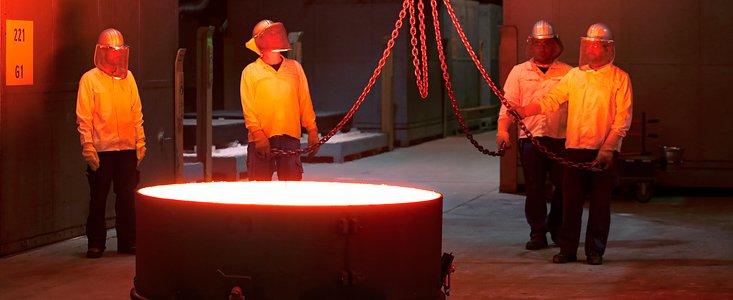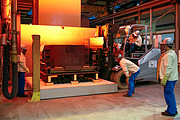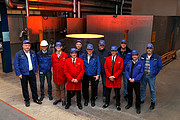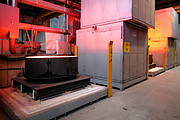Pressmeddelande
De första segmenten till ELT:s huvudspegel har gjutits
9 januari 2018
Nu finns de första sex hexagonala segmenten till huvudspegeln för ESO:s Extremely Large Telescope (ELT). Segmenten, som har gjutits av det tyska företaget SCHOTT vid deras anläggning i Mainz, utgör en del av ELT:s 39 meter stora huvudspegel. Den kommer att bestå av totalt 798 segment när den är färdig. När ELT ser sitt första ljus 2024 kommer teleskopet att vara det största i världen för synligt ljus.
Den 39 meter stora primärspegeln som nu gjuts för ESO:s Extremely Large Telescope kommer att vara den största i sitt slag som hittills tillverkats. En sådan bjässe är alldeles för stor för att vara tillverkad i ett enda stycke av glas. Istället kommer spegeln att bestå av 798 enskilda sexkantiga segment. Varje segment kommer att vara 1,4 meter tvärsöver och cirka 5 centimeter tjockt. Tillsammans kommer de att arbeta som en enda stor spegel för att samla in tiotals miljoner gånger mer ljus än det mänskliga ögat. Marc Cayrel, chef för ELT:s optomekaniska grupp vid ESO, var närvarande vid de första gjutningarna. – Det var en underbar känsla att se de första segmenten gjutas. Detta är en viktig milstolpe för ELT! Precis som teleskopets sekundärspegel gjuts ELT:s huvudspegel i det lågexpansiva keramiska materialet Zerodur© [1] från SCHOTT. ESO har tilldelat det tyska företaget kontrakt för att producera råglaset till de första fyra ELT-speglarna (M1, M2, M3 och M4, där M1 är primärspegeln) (eso1704). Att just de första segmenten nu gjutits är ett viktigt steg. Nu kan ingenjörerna vid SCHOTT utvärdera tillverkningsprocessen, samt att optimera den och verktygen som ingår i den. Med gjutningen av de sex första segmenten har en viktig milstolpe passerats, men vägen framåt är lång. Totalt ska fler än 900 segment gjutas och poleras: 798 till primärspegeln, plus 133 i reserv. När produktionstakten är i full gång kommer man kunna producera ungefär ett segment per dag. Efter gjutningen kommer råglaset till spegelsegmenten att gå igenom en långsam kylnings- och värmebehandlingsprocess. Sedan slipas det till rätt form och poleras till en precision på 15 nanometer utmed hela den optiska ytan. Formningen och poleringen utförs av det franska företaget Safran Reosc som också kommer att ansvara för ytterligare tester (eso1717).
Noter
[1] Zerodur© utvecklades ursprungligen för astronomiska teleskop under sent 1960-tal. Materialet har en extremt låg värmeutvidgningskoefficient, vilket betyder att det inte expanderar även när temperaturen varierar mycket. Kemiskt är Zerodur© väldigt resistent och kan poleras till en hög standard för ytbehandling. Det reflekterande skiktet, som består av aluminium eller silver, läggs vanligtvis på den extremt släta ytan genom förångning strax innan ett teleskop tas i drift och med jämna mellanrum efteråt. Många kända teleskop som använder Zerodur©-speglar har varit i drift under många decennier, bland dem ESO:s Very Large Telescope i Chile.
Mer information
ESO, Europeiska sydobservatoriet, är Europas främsta samarbetsorgan för astronomisk forskning och världens mest produktiva astronomiska observatorium. Det stöds av 16 länder: Belgien, Brasilien, Danmark, Finland, Frankrike, Italien, Nederländerna, Polen, Portugal, Schweiz, Spanien, Storbritannien, Sverige, Tjeckien, Tyskland och Österrike. ESO:s ambitiösa verksamhet rör design, konstruktion och drift av avancerade markbaserade forskningsanläggningar som gör det möjligt för astronomer att göra banbrytande vetenskapliga upptäckter. ESO spelar dessutom en ledande roll i att främja och organisera samarbeten inom astronomisk forskning. ESO driver tre unika observationsplatser i Chile: La Silla, Paranal och Chajnantor. Vid Paranal finns Very Large Telescope, världens mest avancerade observatorium för synligt ljus, och två kartläggningsteleskop. VISTA arbetar i infrarött ljus och är världens största kartläggningsteleskop och VST (VLT Survey Telescope) är det största teleskopet som konstruerats enbart för att kartlägga himlavalvet i synligt ljus. ESO är en huvudpartner i ALMA, världens hittills största astronomiska projekt. Och på Cerro Armazones, nära Paranal, bygger ESO det europeiska extremt stora 39-metersteleskopet för synligt och infrarött ljus, E-ELT. Det kommer att bli ”världens största öga mot himlen”.
Länkar
Mer information om ELT Mer information om SCHOTT Mer information om Safran Reosc
Kontakter
Marc Cayrel
ESO, Head of ELT Optomechanics
Garching bei München, Germany
Tel: +49 89 3200 6685
E-post: mcayrel@eso.org
Richard Hook
ESO Public Information Officer
Garching bei München, Germany
Tel: +49 89 3200 6655
Mobil: +49 151 1537 3591
E-post: rhook@eso.org
Johan Warell (Presskontakt för Sverige)
ESO:s nätverk för vetenskaplig kommunikation
Skurup, Sverige
Tel: +46-706-494731
E-post: eson-sweden@eso.org
Om pressmeddelandet
| Pressmeddelande nr: | eso1801sv |
| Namn: | Extremely Large Telescope |
| Typ: | Unspecified : Technology : Observatory : Telescope |
| Facility: | Extremely Large Telescope |
Our use of Cookies
We use cookies that are essential for accessing our websites and using our services. We also use cookies to analyse, measure and improve our websites’ performance, to enable content sharing via social media and to display media content hosted on third-party platforms.
ESO Cookies Policy
The European Organisation for Astronomical Research in the Southern Hemisphere (ESO) is the pre-eminent intergovernmental science and technology organisation in astronomy. It carries out an ambitious programme focused on the design, construction and operation of powerful ground-based observing facilities for astronomy.
This Cookies Policy is intended to provide clarity by outlining the cookies used on the ESO public websites, their functions, the options you have for controlling them, and the ways you can contact us for additional details.
What are cookies?
Cookies are small pieces of data stored on your device by websites you visit. They serve various purposes, such as remembering login credentials and preferences and enhance your browsing experience.
Categories of cookies we use
Essential cookies (always active): These cookies are strictly necessary for the proper functioning of our website. Without these cookies, the website cannot operate correctly, and certain services, such as logging in or accessing secure areas, may not be available; because they are essential for the website’s operation, they cannot be disabled.
Functional Cookies: These cookies enhance your browsing experience by enabling additional features and personalization, such as remembering your preferences and settings. While not strictly necessary for the website to function, they improve usability and convenience; these cookies are only placed if you provide your consent.
Analytics cookies: These cookies collect information about how visitors interact with our website, such as which pages are visited most often and how users navigate the site. This data helps us improve website performance, optimize content, and enhance the user experience; these cookies are only placed if you provide your consent. We use the following analytics cookies.
Matomo Cookies:
This website uses Matomo (formerly Piwik), an open source software which enables the statistical analysis of website visits. Matomo uses cookies (text files) which are saved on your computer and which allow us to analyze how you use our website. The website user information generated by the cookies will only be saved on the servers of our IT Department. We use this information to analyze www.eso.org visits and to prepare reports on website activities. These data will not be disclosed to third parties.
On behalf of ESO, Matomo will use this information for the purpose of evaluating your use of the website, compiling reports on website activity and providing other services relating to website activity and internet usage.
Matomo cookies settings:
Additional Third-party cookies on ESO websites: some of our pages display content from external providers, e.g. YouTube.
Such third-party services are outside of ESO control and may, at any time, change their terms of service, use of cookies, etc.
YouTube: Some videos on the ESO website are embedded from ESO’s official YouTube channel. We have enabled YouTube’s privacy-enhanced mode, meaning that no cookies are set unless the user actively clicks on the video to play it. Additionally, in this mode, YouTube does not store any personally identifiable cookie data for embedded video playbacks. For more details, please refer to YouTube’s embedding videos information page.
Cookies can also be classified based on the following elements.
Regarding the domain, there are:
- First-party cookies, set by the website you are currently visiting. They are stored by the same domain that you are browsing and are used to enhance your experience on that site;
- Third-party cookies, set by a domain other than the one you are currently visiting.
As for their duration, cookies can be:
- Browser-session cookies, which are deleted when the user closes the browser;
- Stored cookies, which stay on the user's device for a predetermined period of time.
How to manage cookies
Cookie settings: You can modify your cookie choices for the ESO webpages at any time by clicking on the link Cookie settings at the bottom of any page.
In your browser: If you wish to delete cookies or instruct your browser to delete or block cookies by default, please visit the help pages of your browser:
Please be aware that if you delete or decline cookies, certain functionalities of our website may be not be available and your browsing experience may be affected.
You can set most browsers to prevent any cookies being placed on your device, but you may then have to manually adjust some preferences every time you visit a site/page. And some services and functionalities may not work properly at all (e.g. profile logging-in, shop check out).
Updates to the ESO Cookies Policy
The ESO Cookies Policy may be subject to future updates, which will be made available on this page.
Additional information
For any queries related to cookies, please contact: pdprATesoDOTorg.
As ESO public webpages are managed by our Department of Communication, your questions will be dealt with the support of the said Department.








